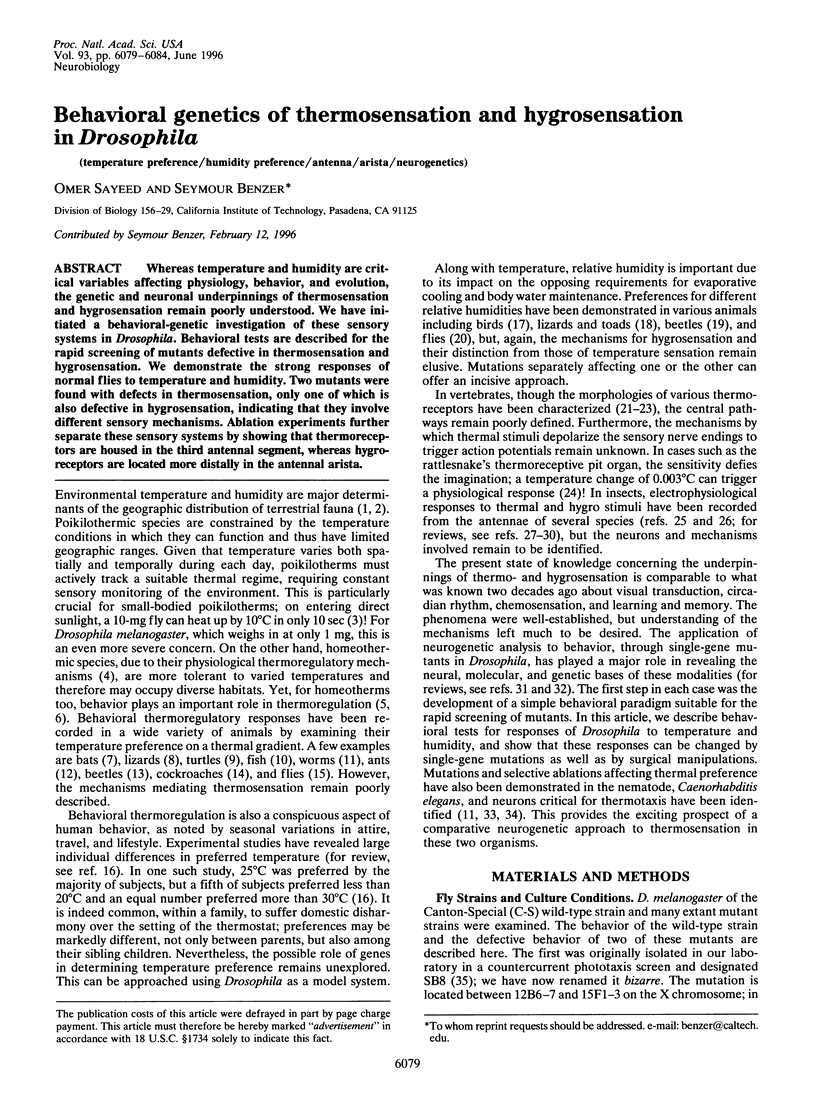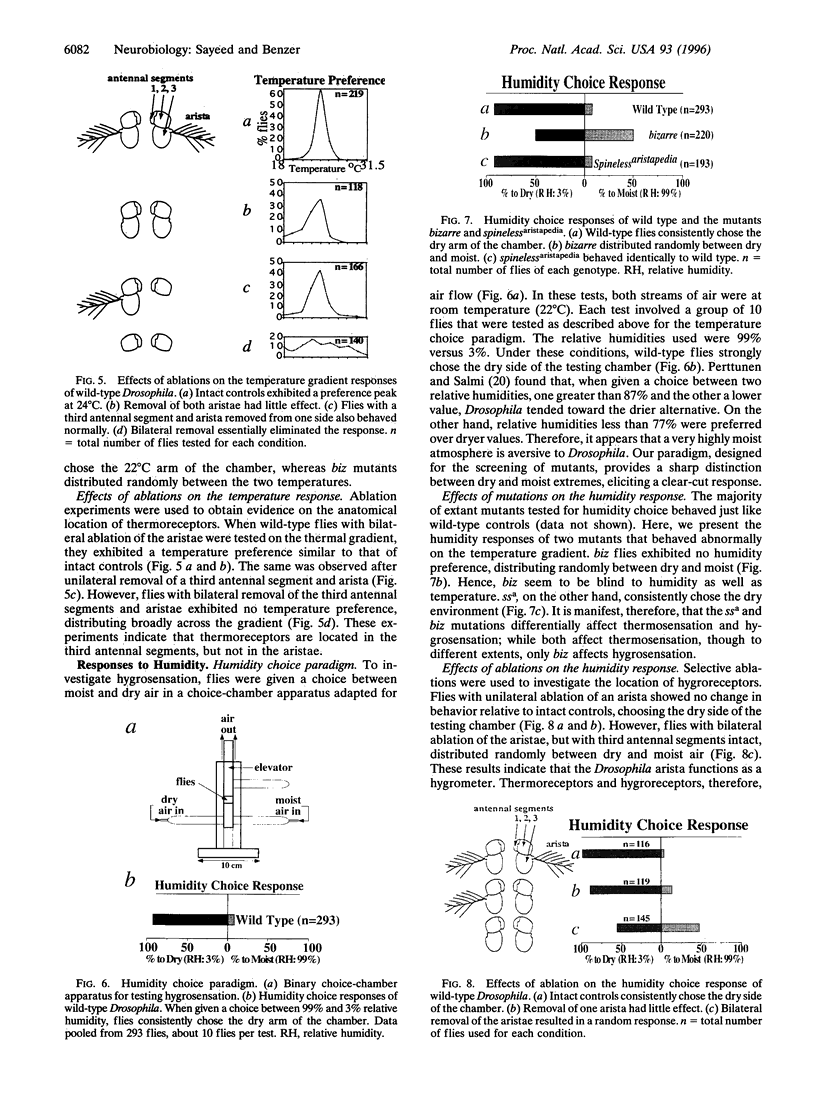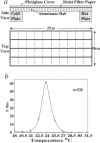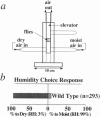Abstract
Whereas temperature and humidity are critical variables affecting physiology, behavior, and evolution, the genetic and neuronal underpinnings of thermosensation and hygrosensation remain poorly understood. We have initiated a behavioral-genetic investigation of these sensory systems in Drosophila. Behavioral tests are described for the rapid screening of mutants defective in thermosensation and hygrosensation. We demonstrate the strong responses of normal flies to temperature and humidity. Two mutants were found with defects in thermosensation, only one of which is also defective in hygrosensation, indicating that they involve different sensory mechanisms. Ablation experiments further separate these sensory systems by showing that thermoreceptors are housed in the third antennal segment, whereas hygroreceptors are located more distally in the antennal arista.
Full text
PDF





Images in this article
Selected References
These references are in PubMed. This may not be the complete list of references from this article.
- Altner H., Schaller-Selzer L., Stetter H., Wohlrab I. Poreless sensilla with inflexible sockets. A comparative study of a fundamental type of insect sensilla probably comprising thermo- and hygroreceptors. Cell Tissue Res. 1983;234(2):279–307. doi: 10.1007/BF00213769. [DOI] [PubMed] [Google Scholar]
- BULLOCK T. H., DIECKE F. P. Properties of an infra-red receptor. J Physiol. 1956 Oct 29;134(1):47–87. doi: 10.1113/jphysiol.1956.sp005624. [DOI] [PMC free article] [PubMed] [Google Scholar]
- Benzer S. BEHAVIORAL MUTANTS OF Drosophila ISOLATED BY COUNTERCURRENT DISTRIBUTION. Proc Natl Acad Sci U S A. 1967 Sep;58(3):1112–1119. doi: 10.1073/pnas.58.3.1112. [DOI] [PMC free article] [PubMed] [Google Scholar]
- Boulant J. A., Dean J. B. Temperature receptors in the central nervous system. Annu Rev Physiol. 1986;48:639–654. doi: 10.1146/annurev.ph.48.030186.003231. [DOI] [PubMed] [Google Scholar]
- Brown C. R., Bernard R. T. Thermal preference of Schreiber's long-fingered (Miniopterus schreiberisii) and Cape horseshoe (Rhinolophus capensis) bats. Comp Biochem Physiol Comp Physiol. 1994 Mar;107(3):439–449. doi: 10.1016/0300-9629(94)90023-x. [DOI] [PubMed] [Google Scholar]
- Crawshaw L. I., Hammel H. T. Behavioral regulation of internal temperature in the brown bullhead, Ictalurus nebulosus. Comp Biochem Physiol A Comp Physiol. 1974 Jan;47(1):51–60. doi: 10.1016/0300-9629(74)90050-4. [DOI] [PubMed] [Google Scholar]
- Dudai Y., Jan Y. N., Byers D., Quinn W. G., Benzer S. dunce, a mutant of Drosophila deficient in learning. Proc Natl Acad Sci U S A. 1976 May;73(5):1684–1688. doi: 10.1073/pnas.73.5.1684. [DOI] [PMC free article] [PubMed] [Google Scholar]
- Foelix R. F., Stocker R. F., Steinbrecht R. A. Fine structure of a sensory organ in the arista of Drosophila melanogaster and some other dipterans. Cell Tissue Res. 1989 Nov;258(2):277–287. doi: 10.1007/BF00239448. [DOI] [PubMed] [Google Scholar]
- Hedgecock E. M., Russell R. L. Normal and mutant thermotaxis in the nematode Caenorhabditis elegans. Proc Natl Acad Sci U S A. 1975 Oct;72(10):4061–4065. doi: 10.1073/pnas.72.10.4061. [DOI] [PMC free article] [PubMed] [Google Scholar]
- Hotta Y., Benzer S. Genetic dissection of the Drosophila nervous system by means of mosaics. Proc Natl Acad Sci U S A. 1970 Nov;67(3):1156–1163. doi: 10.1073/pnas.67.3.1156. [DOI] [PMC free article] [PubMed] [Google Scholar]
- Hotta Y., Benzer S. Mapping of behaviour in Drosophila mosaics. Nature. 1972 Dec 29;240(5383):527–535. doi: 10.1038/240527a0. [DOI] [PubMed] [Google Scholar]
- Manning A. Antennae and sexual receptivity in Drosophila melanogaster females. Science. 1967 Oct 6;158(3797):136–137. doi: 10.1126/science.158.3797.136. [DOI] [PubMed] [Google Scholar]
- Morgareidge K. R., Hammel H. T. Evaporative water loss in box turtles: effects of rostral brainstem and other temperatures. Science. 1975 Jan 31;187(4174):366–368. doi: 10.1126/science.1111111. [DOI] [PubMed] [Google Scholar]
- Mori I., Ohshima Y. Neural regulation of thermotaxis in Caenorhabditis elegans. Nature. 1995 Jul 27;376(6538):344–348. doi: 10.1038/376344a0. [DOI] [PubMed] [Google Scholar]
- Perkins L. A., Hedgecock E. M., Thomson J. N., Culotti J. G. Mutant sensory cilia in the nematode Caenorhabditis elegans. Dev Biol. 1986 Oct;117(2):456–487. doi: 10.1016/0012-1606(86)90314-3. [DOI] [PubMed] [Google Scholar]
- Quinn W. G., Harris W. A., Benzer S. Conditioned behavior in Drosophila melanogaster. Proc Natl Acad Sci U S A. 1974 Mar;71(3):708–712. doi: 10.1073/pnas.71.3.708. [DOI] [PMC free article] [PubMed] [Google Scholar]
- Shelford V. E. A COMPARISON OF THE RESPONSES OF ANIMALS IN GRADIENTS OF ENVIRONMENTAL FACTORS WITH PARTICULAR REFERENCE TO THE METHOD OF REACTION OF REPRESENTATIVES OF THE VARIOUS GROUPS FROM PROTOZOA TO MAMMALS. Science. 1918 Aug 30;48(1235):225–230. doi: 10.1126/science.48.1235.225. [DOI] [PubMed] [Google Scholar]
- Stocker R. F., Lawrence P. A. Sensory projections from normal and homoeotically transformed antennae in Drosophila. Dev Biol. 1981 Mar;82(2):224–237. doi: 10.1016/0012-1606(81)90448-6. [DOI] [PubMed] [Google Scholar]
- Yamamoto A. H. Diallel analysis of temperature preference in Drosophila immigrans. Jpn J Genet. 1994 Feb;69(1):77–86. doi: 10.1266/jjg.69.77. [DOI] [PubMed] [Google Scholar]






